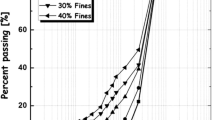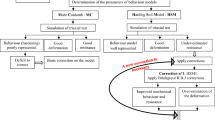Abstract
The lumpy soil is a by product of the open-pit mining. A composite-lumpy material (in which, the lumps are randomly distributed in the reconstituted soil) is being created due to the degradation of the initial granular structure. In the present study, the compression and failure behaviour of an artificial lumpy material with randomly distributed inclusions are investigated using the finite element method. The computation results show that the stress ratio, defined as the ratio of the volume average stress between the lumps and the reconstituted soil within the inter-lump voids, is significantly affected by both the volume fraction and the preconsolidation pressure of the lumps under an isotropic compression path, while the volume fraction of the lumps plays a minor role under a triaxial compression path. Based on the simulation results, a homogenization law was proposed utilizing the secant stiffnesses.





















Similar content being viewed by others
Notes
Naturally, there is a shallow unsaturated zone in the clayfills during dry periods. However, this zone would turn to be saturated in wet seasons and landslides frequently occur at the periphery of landfills.
The sample was isotropically consolidated at 200 kPa before triaxial shear test; therefore, OCR indicates the preconsolidation pressure of the lumps related to the consolidation pressure of the entire sample (OCR*200 kPa).
References
Agari Y, Uno T (1986) Estimation on the thermal conductivities of the filled polymers. J Appl Polym Sci 32:5705–5712
Butterfield R (1979) A natural compression law for soils. Géotechnique 29(4):469–480
Doležalová M, Kořán P (2002) Micromechanical modelling of a dump material. Int J Geomech 2(1):47–74
Dow NF (1961) Study of stresses near a discontinuity in a filament-reinforced composite metal. Technical information series, report R63SD61, General Electric Company
Herle I, Kolymbas D (2004) Hypoplasticity for soils with low friction angles. Comput Geotech 31:365–373
Herstus J (1999) A landfill site investigation for placing a waste disposal (in Czech). Report for research grant GACR 103/99/0753, Prague
Koliji A, Vulliet L, Laloui L (2008) New basis for the constitutive modelling of aggregated soils. Acta Geotech 3(1):61–69
Kostkanová V, Herle I, Boháč J (2014) Transitions in structure of clay fills due to suction oscillations. Procedia Earth Planet Sci 9:153–162
Mašín D (2005) A hypoplastic constitutive model for clays. Int J Numer Anal Meth Geomech 28(4):311–336
Mašín D (2012) Hypoplastic cam-clay model. Géotechnique 62(6):549–553
Mašín D, Herbstová V, Boháč J (2005) Properties of double porosity clayfills and suitable constitutive models. In: Proceedings of the 16th international conference of ICSMGE, Osaka, Japan, pp 827–830
Najser J, Mašín D, Boháč J (2012) Numerical modelling of lumpy clay landfill. Int J Numer Anal Meth Geomech 36:17–35
Reuss A (1929) Berechnung der Fliessgrenzen von Mischkristallen auf Grund der Plastizitatsbedingung fuer Einkristalle. Zeitschrift fuer angewandte Mathematik und Mechanik 9:49–58
Riley VR (1969) A strength prediction of aggregate composites. J Compos Mater 3(1):82–93
Rosen BW, Dow NF, Hashin Z (1964) Mechanical properties of fibrous composites. NASA rept. CR-31
Shi XS, Herle I (2014) Laboratory investigation of artificial lumpy materials. Eng Geol 183:303–314
Shi XS, Herle I (2015) Compression and undrained shear strength of remolded clay mixtures. Géotech Lett 5:62–67
Voigt W (1928) Lehrbuch der Kristallphysik. Teubner Verlag, Berlin-Leipzig
Acknowledgments
The authors thank Mr M. Wiebicke and Mr J. Hleibieh for the discussions on the simulations. The first author gratefully acknowledges the China Scholarship Council for grant scholarship number 201206090014. The reviewers are also appreciated for their excellent comments which improved the quality of the paper.
Author information
Authors and Affiliations
Corresponding author
Appendix: Homogenization law using the tangent stiffnesses under isotropic compression load
Appendix: Homogenization law using the tangent stiffnesses under isotropic compression load
Analogous to the secant stiffnesses, the tangent ones (hydrostatic \(\bar{K}_{h}\) and deviatoric \(\bar{G}_{d}\) parts, together with their counterparts \(\bar{K}_{d}\) and \(\bar{G}_{h}\)) are defined as
The corresponding homogenization law is expressed as
The relationships between the tangent stiffnesses are shown in Fig. 22. Obviously, the simulation results from Sect. 3.1 fit excellently the homogenization law during isotropic loading in terms of the tangent stiffness.
Rights and permissions
About this article
Cite this article
Shi, X.S., Herle, I. Numerical simulation of lumpy soils using a hypoplastic model. Acta Geotech. 12, 349–363 (2017). https://doi.org/10.1007/s11440-016-0447-7
Received:
Accepted:
Published:
Issue Date:
DOI: https://doi.org/10.1007/s11440-016-0447-7





